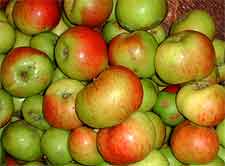How To Make Apple Jelly
Homemade Jam Recipes
Ingredients: Apple Jelly Recipe

6 lb / 2,700 grams of cooking apples
2 lemons
2 1/2 lb / 1,150 grams - approximately (granulated or caster is fine)
47 fl oz / 1,400 ml of tap water
3 teaspoons of cinnamon (this is optional)
Method - What To Do
This simple jelly recipe works best when using cooking apples, such as Bramleys or Grenadiers, rather than eaters. Damaged windfall apples can be used successfully and this jelly is a good way to make use of windfalls, rather than simply leaving them to rot and be eaten by troublesome wasps.
Wash all of the apples and cut out any bad bruising or damage. Chop them into slices, using the skin and the core. Place all of the apple pieces (including any sections of core) in a deep preserving pan and cover with the water. Boil the fruit for around 30 minutes, or until well and truly softened.
Take the pan off the stove heat and strain the apples through muslin (or a similar fine material or strainer). Leave this pulp to drip freely, collecting the juices beneath. Do not squeeze the bag or press the pulp, as if any of the apple pulp finds its way through the strainer, it may end up making the final jelly a little cloudy. If you do not have a muslin bag, try covering a large colander with muslin and sit this above a wide pan.
Leave your apple pulp until it has stopped dripping. As this will take several hours, it may be easiest to just leave it to drip overnight and return to this recipe in the morning. Measure the juice that has been collected with a jug. For every pint of juice (16 fl oz / 475 ml) that has been collected, add 1 lb / 500 grams of white sugar. These proportions can be altered slightly, according to your tastebuds. The quantity of sugar could be reduced to 14 oz / 400 grams per pint (or perhaps 13 1/2 oz / 380 grams per pint) if you have less of a sweet tooth, but no less, as it will start to affect its ability to set.
Stir in the sugar so that it is fully absorbed and dissolved in the juice, leaving you with just a slightly cloudy liquid. If you are adding the cinnamon, sprinkle this over and stir into the liquid. Bring this mixture to a rolling boil and keep stirring, otherwise you run the risk of it burning on the bottom. Leave the mixture on a medium-boil for around 15 to 20 minutes, or until you feel that it is ready to test for its jelling point. As it boils, you will notice the apple jelly begin to clarify and reach a deeper, richer colour, indicating that it is almost ready.
Spoon a small amount of the mixture onto a saucer (one that has been chilled at the back of a fridge or ideally, in a deep freeze). Leave this jelly for a minute and then run your fingertip through it, to see if it wrinkles and is setting. If it does not wrinkle in this way and does not have a skin, then boil the jelly for a few more minutes and test once more, and for a third or fourth time if required.
When you are quietly confident that your apple jelly is ready to set, take the pan off the stove and skim the surface. You can mix in a small chunk of butter if any scum remains, as this will assist it in dispersing. Finally, pour the jelly into glass jars (sterilised in the usual jam making way).
Apple Jelly Recipe - More Jelly Recipes.
 6 lb / 2,700 grams of cooking apples
6 lb / 2,700 grams of cooking apples